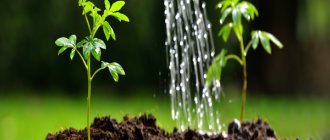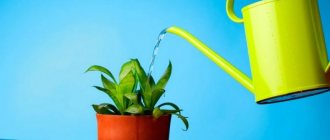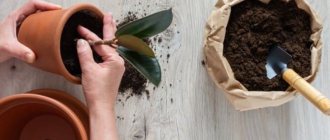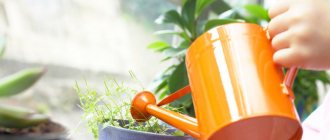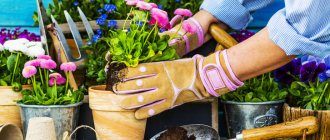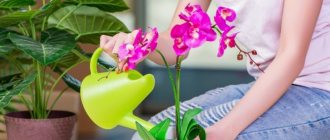How often to water house plants
Due to the fact that there are plenty of factors influencing the frequency and abundance of hydration, an individual approach is required for each flower. However, there are general recommendations that tell you how to water your house flowers:
- material used in making a pot. Representatives of the same species growing in pots made of clay and plastic need to be watered differently. The first will require more moisture than the second, since the water in it also leaves through the porous walls;
- The size of the pot also plays a role. Obviously, a large pot will require more water than a small one;
Watering indoor flowers
- location of the bush. Watering indoor plants located on the south side should be more intensive, especially during the warm period;
- air temperature. Plants located in a warm room need to be watered more often and more intensively than those located in a cool room. By following this rule, you can avoid drying out the soil or rotting the roots;
- the weather, which also determines how often indoor flowers need to be watered. In hot weather, the amount of water should be increased and vice versa.
Important! In everything you need to know when to stop. And in the heat, you should not water the flower garden too intensively; this should be done only as needed. And most importantly, you need to focus on the type and botanical group of the indoor flower.
Watering frequency
How often to water the garden is another important question. The frequency of watering depends on the agricultural technology of the crops and what stage of growth they are at. If these are young plants (seedlings), then they need to be watered daily - in the morning or evening. After the plants adapt and take root, the frequency of watering is reduced to 1 time every 3-3 days.
Many gardeners add nutritional components to irrigation water - an infusion of onion peels, an ash solution. Thus, the plants receive not only the necessary amount of moisture, but also complex nutrition. To achieve the best effect, in order to prevent an excess of nutrients in the soil, watering with plain water alternates with medicinal infusions.
The frequency of watering is affected by the location of the plant root system. For example, plants of the Pumpkin family - cucumbers and zucchini - are moistened no more than once every 3 days. The root system of these plants is located deep in the ground. Tomatoes and cabbage are plants with a shallow root system and require more frequent watering - every other day.
As for fruit trees and shrubs, these crops are drought-resistant. They are watered less frequently than garden beds. The exception is young seedlings, which require frequent moisture, especially in the summer heat.
To properly water plants in the garden, gardeners use a hose with a watering can and shower head. With the help of such a device, the soil is not clogged and is moistened evenly. In this case, it is necessary to apply moderate water pressure so that during watering the above-ground part of the plants and the roots located near the surface are not damaged.
For irrigation in hot weather, it is better to use settled water from a barrel. In addition, garden crops need rainwater, which can be collected in any capacious container and then used to water the beds.
If your plot is on the coast near a river or pond, then it is simply impossible to find better water for your garden. Firstly, it is at the optimal temperature, and secondly, it does not contain chlorine, like in the water supply, and in addition, it is saturated with all sorts of microorganisms that are simply irreplaceable for improving the structure of the soil. You can read how to organize irrigation from a river in this article.
Watering indoor plants in spring, summer, autumn and winter
DIY drip irrigation for indoor plants
There are several main periods: active growth and vegetation (spring-autumn), flowering period (most often in summer) and dormant period (winter). Caring for flowers in each of them should be different from the previous one so that they give lush, lush greenery and bright blooms.
How often to water indoor flowers in winter is not always easy to understand. Firstly, each flower has its own time frame for this period, for some it does not occur at all. Secondly, each individual species needs individual conditions. The frequency of soil irrigation depends on these parameters.
In winter, daylight hours are reduced, and many plants also need to reduce the air temperature in order to properly rest. If you manage to do this, then watering should be done rarely, as the soil dries out. Some species (for example, begonia) take a break from water altogether in winter. But, if it was not possible to ensure a low temperature, then watering should be reduced. Most often it is produced 2-3 times less often than in summer.
Indoor flowers during the dormant period
By spring, plants gradually awaken from winter sleep, move into a new phase and should be provided with proper watering. It becomes more frequent and intense. Summer, especially hot summer, is the period of the most abundant and frequent soil moisture. By autumn everything gradually decreases again.
Important! If the summer turns out to be cold and rainy, you should not be overzealous with the amount of water, this can cause rotting of the roots, especially in sensitive flowers. Because of this, they may die.
Watering vegetables in open ground
Let's look at the watering requirements for some of the most common vegetable crops.
There are 4 groups of vegetables based on their ability to absorb water. For ease of remembering, we have placed them in a table.
| Group | Water requirement | Name of culture |
| 1 | They use up water quickly; fractional but frequent watering is required. | Cabbage, cauliflower, Chinese cabbage, kohlrabi, lettuce, radish, cucumber, spinach, celery |
| 2 | They have a developed root system and are able to extract water at a depth of up to 80 cm. Moisture consumption is economical, so frequent watering is not required. | Tomatoes, carrots, melons |
| 3 | They use water sparingly, although it is not easy for them to extract it from the soil. They need watering only during the first half of growth. | Onions, spring onions, garlic and other onion crops |
| 4 | Absorbs water well and uses it intensively. Responds gratefully to irrigation. | Beet |
Watering also depends on the period of plant growth and soil composition. For young tomato and pepper plants, 0.5 liters per bush is enough. During the flowering period, the norm increases to 0.7 liters. And adult plants need at least 1 liter of water. Cucumbers are more moisture-loving, and they require 0.7 liters even before flowering begins. During fruit formation - 1 liter, and after - at least 1.5 liters per plant.
As for the soil, keep in mind that sandy and light loamy soil dries out much faster than clayey and loamy soil. This means that the plants in it need to be watered more often.
Squeeze a handful of soil in your hand; if a lump has not formed, the soil is too dry.
How to water tomatoes in open ground
1-2 times a week, preferably in the morning, under the root with settled or collected rainwater at the rate of about 30 liters per 1 sq.m. Tomatoes without watering begin to signal their poor condition: the leaves become smaller and turn yellow, curl, the ovaries fall off, the resulting fruits slow down their growth and ripening, and in critical cases, blossom end rot appears on them.
How to water ground cucumbers
After the flowers appear, be sure to use warm water every 3-4 days at the rate of about 30 liters per 1 sq.m. You should not water under the root - if the root collar is constantly flooded, the root may rot. In addition, in good weather, cucumbers tolerate any other method of watering (sprinkling, over leaves).
- How to water cucumbers correctly for a good harvest
Everything you need to know about watering cucumbers, depending on the time of year and growing conditions.
How often to water peppers and eggplants in open ground
For uniform growth and full flowering, they require constant soil moisture, but do not tolerate sprinkling. Water them at the root 1-2 times a week with warm, settled water at the rate of about 15-25 liters per 1 sq.m, soaking the soil under the bushes to a depth of at least 25-30 cm. At temperatures below 15°C, watering should be stopped altogether; in order to avoid damage to plants by gray rot.
How often to water cabbage in the garden
Watering cabbage in open ground should be abundant and frequent - every 2-3 days at a rate of at least 30 liters per 1 sq.m., soaking the soil to a depth of at least 40 cm. In this case, the water can be quite cool. In hot weather, you can use sprinkling; in cloudy weather, water at the root. When there is a lack of moisture, cabbage is actively attacked by pests - cabbage fly and cruciferous flea beetle.
How often to water carrots in open ground
1-2 times a week with cool water at the rate of about 30 liters per 1 sq.m., or sprinkling. The root crop is most demanding of moisture in the first half of the growing season (signaling a lack of liquid by darkened, curled leaves), then the norm can be reduced, and three weeks before harvesting, watering can be stopped altogether.
Is it possible to water beets with cool water?
Yes, it is also not capricious in terms of watering temperature - the main thing is that the soil is moistened at least 30 cm deep. Moreover, over the entire season, in normal, non-drying weather, it is enough to water the beets only 4-5 times, by sprinkling or at the root in the morning at the rate of about 30 liters per 1 sq.m. The plant will “inform” about a lack of moisture by the darkened (purple-brown) color of the tops and the release of flower stalks instead of the formation of root crops.
How to properly water onions and garlic in the garden
These crops should not be watered too much - they are very “thirsty” only during the period of bulb formation, when they will have to allocate at least 35 liters per 1 sq.m. Before this, watering once a week is enough, moistening the soil only 10-15 cm deep (look at the tips of the feather to see if they have begun to turn yellow). About a month before harvesting, watering should be stopped altogether: excess moisture will cause the bulbs to ripen worse and will be poorly stored in winter.
Do not forget that the attitude to watering can be different even within the same crop for different varieties. In general, varieties of early ripening are more demanding in terms of moisture, while later varieties are less demanding.
If 10-12 cm of soil is saturated with moisture, it means you did everything right and the plants will not suffer from thirst.
When to water indoor flowers: time of day to water houseplants
Watering indoor plants in the absence of owners for 2 weeks or a month
The ideal time of day for watering is morning. This has been known for a long time and has been scientifically proven. After all, during the day the moisture has time to evaporate, and watering in the evening leads to the opposite result. Excess liquid can accumulate at the roots, which will not lead to anything good. Due to increased dampness, fungal infections can develop, and the underground part of the plant will no longer receive the necessary oxygen.
For your information! It's sad but true: more plants die from improper watering than from all other factors combined.
Determining the watering time
From the above it is clear that the plant must be fully provided with water if we are interested in the harvest. Now it remains to determine when to water.
To obtain a harvest, it is necessary to provide plants with water.
Water in the morning
When watering early in the morning, the plants will be in good shape (turgor) and provided with a supply of minerals throughout the day. In the heat, they will have something to evaporate, cooling themselves. Bright sun and rising temperatures in the afternoon stimulate the processes of growth and fruit filling at night.
But by the evening, the plant may exhaust all its moisture reserves, and there will be no water left in the soil for growth (increasing the number and size of cells). A nighttime drop in temperature and condensation will restore freshness to the leaves and in the morning will deceptively please the gardener with the cheerful appearance of his charges. Having received the next watering portion, the plant will begin photosynthesis and transpiration with renewed vigor. And the harvest suffers: there was no water for overnight growth. Having been saturated with moisture early in the morning, the plants strive to make up for lost time. This leads to cracking of the fruit: the pulp grows, but the peel does not have time.
The result of untimely watering
The second problem is the occurrence of a lack of microelements (for example, calcium) and, as a consequence, the appearance of blossom end rot. The plant spends liquid on growth and stops the “pump” pumping the nutrient solution.
Water in the evening
Evening watering provides the necessary resources for growth. But if the amount of water is not enough, the plant will be limited in water on a hot day - transpiration decreases. Losing moisture, the leaves will become lethargic, and the area of absorption of solar energy and CO₂ will decrease. To reduce evaporation, the stomata will close, which means less carbon dioxide will be used. Accordingly, the efficiency of photosynthesis will decrease - plants will accumulate less sugars. The lack of moisture will also affect the operation of the “pump” that supplies nutrients.
We water in the evening: water is used more economically
When to water plants in a greenhouse
You can water in excess so that there is enough for all the needs of the plant - both daytime and nighttime. But here another problem that is relevant for closed ground may appear - high humidity and fungal and bacterial infections.
Proponents of morning irrigation believe that watering early in the day, as opposed to in the evening, eliminates this problem - the sun will dry it out. However, in fact, when water is released into the greenhouse space in the evening, less evaporates:
- When watering cooling soil, moisture penetrates faster and deeper into the bed. In the morning, on the contrary, the soil begins to heat up and evaporate the newly added water;
- in the dark, most plants practically do not evaporate - but during the day, on the contrary, air humidity increases greatly due to transpiration. In the evening, warm air saturated with water vapor comes into contact with the cooling walls of the greenhouse, leaves and soil - condensation forms.
Factors influencing the irrigation regime
Fertilizers for indoor plants: varieties and feeding rules
How to properly water home flowers depends on a number of factors. More moisture will be required:
- in a phase of active growth and development;
- when placed in a large flowerpot or made of natural material;
- if the plant has large thin leaves;
- with a pronounced, good, powerful root system;
- at high air temperatures in the warm season;
- at low air humidity;
- with constant ventilation of the room.
Less intensive watering is required:
- in pots where the soil is not particularly loose;
- plants with thick, fleshy leaves or without leaves;
- flowers that have only recently been transplanted from another pot, weak and painful;
- owners of a short root;
- in the phase of slow growth or dormancy;
- in the absence of a drainage layer;
- in low temperature conditions;
- at high air humidity.
Watering peppers
How to water peppers correctly
Peppers have a shallow root system, so they require a lot of moisture.
Watering peppers in the greenhouse is carried out in the first half of the day. It is better to pour water from a watering can directly under the bush, moistening the ground by 10-15 centimeters. In hot, dry summers, peppers are watered every day so as to keep the soil under the plants moist but not flooded.
Under normal weather conditions, it is enough to water the peppers once a week, during the fruiting period - twice a week.
Water temperature for watering peppers
Watering water for peppers should always be warm, around 25°C. Cold water in a watering can can cause the roots to become overcooled. Then the bushes stop growing, and the timing of flowering and fruiting is delayed.
How to water flowers correctly
There are two main ways to water plants - top and bottom. You should choose one method or another based on the type of plant and general recommendations. In any case, you need to water the flowers only with water at room temperature; cold water is stressful for them. Rain or melt water is best; if this is not available, you can water it with settled tap water, but not boiled water, since the boiling process kills all the necessary microelements.
Which is better - top or bottom watering?
The overhead irrigation method is the most common and traditional. With constant watering from above, the soil in the pot is completely and more evenly saturated with moisture, and the plant feels as comfortable as possible. It is worth remembering that you need to water, evenly distributing the moisture over the surface, otherwise grooves will form and the roots may be exposed. Violets, succulents, and indoor banana trees love this type of irrigation the most.
Watering flowers from above
There are times when you can't allow moisture to get on the leaves of your plants, or when they may be sending roots outside the pot. For such plants, the best option is bottom watering. Water is poured into the pan of the pot, and the moisture is absorbed on its own in the amount needed. This is how you need to water Saintpaulias, soleirolias, azaleas, and begonias.
Important! Bottom watering can cause all minerals to rise to the top and even form a white layer on the surface of the soil. In this case, it is necessary to restore the balance using the top moisture supply.
Bottom watering of flowers
Volume of liquid when watering
Depending on the plant’s genus, it needs a certain watering regime, according to which the volume of liquid required is determined:
- abundant. This is done immediately after the soil in the pot has dried. This option is required for almost all tropical bushes, plants with thin, long leaves, and large specimens;
- moderate. It is not done immediately, but after a couple of days. It is needed by flowers with pubescent leaves or stems (for example, violets), thick woody roots (ficus);
- infrequent watering is suitable for cacti and other succulents. With this, the earthen lump can remain dry for up to several weeks.
What water should I use for irrigation?
An important criterion when carrying out irrigation is the temperature and quality of water. For example, the question often arises whether it is possible to water the garden with cold water. This is not recommended, as it can lead to temperature shock to the plants.
Therefore, for this procedure, preference is given to warm water with an optimal temperature of +15 to +25°. Water from a well or borehole is preheated.
Another popular question is whether you can water your garden with water from the pool. This option is only allowed if the liquid is free of chemicals and cleaning agents, for example, from an inflatable pool.
Improper watering: signs and their elimination
If you systematically violate the watering rules required for a particular flower, you can get undesirable consequences, in particular, its death.
Is it possible to revive a dried out houseplant?
If the soil is completely dry, it begins to refuse to accept moisture. Regardless of the amount of water poured, only the upper part of the soil is wetted. This occurs due to the fact that the dried soil decreases in size and lags behind the walls of the pot, forming cracks into which moisture flows and exits through the drainage hole.
To save the situation, you need to water the plant in the shower, then place it in a basin filled with water and wait until the earthen lump is completely wet (all air bubbles should come out of it). Then remove the pot and wait for the excess water to drain. Not all plants are able to withstand a long absence of moisture, but if it succeeds, it will soon turn green again.
Note! It is also important to remember about the gaps that have formed between the soil and the walls of the pot. They need to be filled with fresh soil.
What to do if the flower is flooded
If a florist is faced with the opposite problem, then it is worth remembering that this is as dangerous as drought. But you can save the flower. To do this, you need to carefully remove it from the pot, remove any rotten and weak roots that have appeared and wrap it with an absorbent cloth or waffle towel. If the towel is completely soaked, you should immediately change it to a dry one. Then you need to wrap the lump in paper towels and leave until completely dry. After this, the plant should be planted in a new container filled with fresh soil mixture.
What types of irrigation exist
Based on the purpose they serve, irrigation is divided into the following types:
- moisture charging is carried out in order to create a supply of moisture in the soil. This may be moistening the bed before planting seedlings or before filling containers with soil for planting;
- post-sowing (or pre-sowing) - moisten the soil to the depth of the seeds;
- refreshing is carried out in hot weather using a sprayer. It is also called sprinkling;
- fertilizing - for adding dissolved and liquid fertilizers to the soil;
- anti-frost - in early spring or late autumn, complete wetting of the foliage is carried out;
- Vegetative irrigation is the main type of irrigation that nourishes plants as they grow. The moisture depth should be at least 40 cm.
Watering cabbage
According to the method of irrigation, they are also divided into types: manual or machine sprinkling, overhead irrigation (under the root), underground, spraying.
Note! Water application rates vary depending on the growing period, soil type and climatic conditions.
Drip irrigation is designed to supply moisture to the plants constantly and in doses. Its equipment will take time and require certain expenses, but it will free you from the need to carry a heavy watering hose and will give you the opportunity to do other things while watering.
Drip irrigation systems are commercially available, or you can make them yourself. Advantages of drip irrigation:
- water comes directly to the root of the plant;
- You can add fertilizer along with moisture;
- constant maintenance of soil moisture;
- you can select the desired mode.
Disadvantages include monetary costs for pipes, pump and fittings.
The simplest option for drip irrigation is to use plastic bottles with holes made in them, through which water gradually flows to the stem.
Drip irrigation
What determines a plant’s need for moisture: soil moisture indicators
Flower shops offer a variety of soil moisture meters for indoor plants. The main advantage of such indicators is that, thanks to special sensors, they demonstrate not only the water level in the entire pot, but also its amount specifically at the roots of the plant. Such measurements are especially important for fastidious, high-maintenance plants, for which the liquid level must always be at a certain level: you cannot overdo it or overdry it.
Soil moisture indicator
To care for indoor flowers, you need to feed them in a timely manner, take care of the level of lighting, temperature and air humidity. However, without proper regular watering nothing will work. This is worth taking care of even when the whole family is leaving somewhere and there is no one to water the flowers. For such situations, a special device is suitable, sold in stores and providing automatic watering. It is worth providing the flowers with the necessary care, and they will delight you with their chic appearance and bright, lush blooms.
Is it possible to combine watering with fertilizing?
What is better to water plants: with a hose or a watering can
Fertilizing must be combined with watering so as not to burn the roots with the fertilizer. You can water without fertilizers, but you cannot fertilize without watering.
What feed is best to use?
Feeding is chosen depending on the phase of plant development: at the beginning of the growing season - fertilizers with nitrogen to accelerate the growth of green mass, during flowering and fruit set - with a predominance of potassium and phosphorus. Organic fertilizers should be alternated with mineral ones.
Fertilizing the garden with folk remedies
Can soapy water be used as fertilizer? Some gardeners noticed that pouring soapy water under the bush improved its condition. The fact is that such water can deoxidize the soil. If the acidity of the soil under the bush exceeded the norm, then soapy water can have a beneficial effect. Conclusion: a weak solution of soap will not cause harm, but in case of increased acidity of the soil it can be beneficial.
Pepper feeding
Feeding with whey obtained from making yogurt has become widespread. This product contains many vitamins and beneficial bacteria that inhibit harmful fungi. What can you water with whey in the garden? Fertilizing with whey has a beneficial effect on cucumbers, zucchini, tomatoes and berry crops.
Sea water is considered harmful to plants, although a Dutch farmer recently developed varieties of potatoes and carrots that can grow in salty sea water. But seaweed fertilizers are very effective. Fertilizing for indoor flowers from kelp (sea kale) has become widespread.
Gardeners have long and successfully used tincture of iodine, yeast, tea and coffee, and onion peels as fertilizers. Based on these substances, infusions are prepared, which are dissolved in water in the required proportions and applied to the beds after watering.
Iodine for fertilizers
Indoor plants that love abundant spraying and watering
Now check out how to water flowers at home that love plenty of moisture.
Reed (Sdrpus cernuus). Light green ornamental grass; white flowers the size of a pinhead; no special requirements regarding location; there should always be water in the pan; spray frequently.
Hydrangea (Hydrangea) . Due to the large, soft leaves, the plant consumes a lot of water, especially in summer; use only softened water at room temperature; During the dormant period, water less.
Decorative asparagus, asparagus (Asparagus) . A well-known green element in bouquets; requires constantly moist roots in summer; In winter, water less, especially if the plant is in a cool place.
Indoor bamboo, pogonatherum . Refers to very thirsty plants; If leaves curl, water immediately; on hot days, spray frequently; There is always water in the pan.
Indoor calla lily (Zantedeschia). Comes from the swampy areas of Africa; during the period of growth and flowering, it requires a lot of water; from June to early August, water less; Requires a lot of light for flower development.
Syt (Cyperus) . Looks beautiful in aquariums too; like a marsh plant must always have its roots in the water; It tolerates heat in winter, but needs frequent spraying.
How to water flowers sensitive to lime at home
If you have flowers that are sensitive to lime, they require special watering.
Azalea (Rhododendron simsii) . During flowering, bathe once every 2 weeks; do not spray flowers; put in a cool place; feed lightly; grow in non-carbonate soil.
Brunfelsia (Brunfelsia pauciflora) . Purple flowers bloom in late winter; cannot stand the sun; do not forget about the drainage layer; Do not spray the flowers - they become spotty.
Anthurium. It does not tolerate lime at all and is sensitive to increased concentrations of salts in the soil; take softened, heated water; feed lightly; do not spray the flowers.
Gardenia (Gardenia jasminoides). Wonderful, fragrant flowers; but a very sensitive plant; It blooms better if it is in a cooler place during the budding period; spray frequently, but not the flowers.
Camellia (Camellia) . Flowers range from white and pink to bright red, plain or interspersed; avoid temperature changes; in summer he likes to stand outside; Spray daily in winter.
Aglaonema. Similar to Dieffenbachia, but requires more care; does not tolerate direct sun; likes to always stay warm; needs high air humidity; plant in wide, low pots.
Calathea. A beautiful single plant with a distinctive leaf pattern; should be warm all year round; high air humidity and high soil temperature; loose soil; good drainage of the pot.
Usambara violet (Saintpaulia). Endless variety of colors, including two-tone, smooth or curly leaf edges, beautiful mini plants; do not spray leaves; Water only from below.
Araucaria (Agaicapa). Requires a lot of space to spread branches; do not place in bright sun; keep in a cooler place in winter; spray frequently; feed only lightly.
Bromeliads (Bromeliaceae) . These are attractive exotic plants that arrived in our apartments from Brazil.
All plants of this species, such as:
Aechmea
Neoregelia
Nidularium
They have some features that you should consider, and they will help you when caring for these plants.
Bromeliads form with their long pointed leaves, which are arranged in a circle, something like a funnel or rosette. It should be filled with water, depending on the type, all year or only during the growth period. It is recommended to update the water in the funnel approximately every two weeks.
Quality irrigation starts with water quality
Indoor plants should not be watered with water with untested characteristics, especially tap water, not settled, cold or hot. The water temperature should correspond to the air temperature in the room. It must be left to stand for at least 2-3 days before watering.
The ideal option is melt, rain (subject to a favorable environmental situation) or filtered “drinking” water. It is better not to water indoor plants with boiled water (with rare exceptions), and mineralization is generally strictly prohibited. Some plants may need distilled water.
Even for plants that require submersion or tray watering, the amount of time that water should be left in the outer container should be limited. With classic top watering, any remaining water in the trays should be drained after 5-8 minutes.
Even 10 minutes of stagnation of water in the lower part of the substrate and oversaturation of drainage with water can lead to the onset of negative processes for species sensitive to rot.
Rules for spraying indoor flowers at home
A type of additional provision of moisture to plants is spraying indoor plants with sprayed water. Spraying does not compensate for the lack of watering, and additional watering does not replace spraying.
Water is sprayed onto plants in order to increase humidity in the immediate vicinity of the leaves and thereby reduce evaporation. It is especially necessary to spray home flowers on hot summer days, as well as in winter in apartments with central heating.
For spraying indoor flowers, the same rules apply as for watering:
- Avoid irrigating plants in the midday heat; drops of water on the leaves turn into magnifying glasses and cause burns.
- When spraying house plants, do not spray ice water.
- If possible, use soft water with a low lime content, otherwise unsightly lime spots will appear on the leaves.
The flowers of some plants, such as azalea (Rhododendron) or pavonia, should not be wetted because they become unsightly.
Other plants with sensitive leaves, such as hybrid Saintpaulias (Sainpaulia ionantha), should not be sprayed at all.
Next, you will learn how to water indoor flowers that are too sensitive to lime.
How to irrigate using the immersion method?
This is the so-called bottom watering, in which a flower pot is immersed in a container of water and remains there until the soil absorbs a sufficient amount of moisture. The water level should not reach the edge of the pot; it is quite enough if it is in the middle of the height of the flower pot.
How to leave a flower in a container with water for a long time? There is no need to wait for the soil in the pot to absorb all the water; it still won’t absorb more than the flower needs. Usually half an hour is enough for the flower to get drunk. Excess moisture will flow into the pan; in this case, it is advisable to drain it so as not to cause acidification of the soil at the bottom of the flower pot.
Features of watering: corn, beans, radishes and other vegetables
During the growth process, corn consumes a lot of water (from 2 to 4 liters per day), but it suffers from waterlogging of the soil. The soil moisture under corn should be 70 - 80%. How to water corn in a field? Drip irrigation of corn and irrigation with sprinkler equipment for mass cultivation of the crop have a good effect.
Corn drip irrigation
Another moisture-loving crop is beans. After sowing the seeds and until 4–5 true leaves appear, it requires constant regular watering. At the stage of development of the fifth leaf, watering is stopped, and during the budding period they begin to water again every 7 days. Water should be settled. When the beans begin to ripen, watering must be stopped again.
Before sowing radishes, moisture-recharging watering of the soil is carried out. Then water as the soil dries. In a polycarbonate greenhouse, watering is carried out twice a month; it should be watered abundantly (from 8 to 10 liters per 1 sq. m).
Carrots are watered frequently at the beginning of their growth; little water is required during this period. It is important to control the depth of watering and avoid excess moisture. As the root grows, water less frequently, but water consumption increases.
Important! In hot summers, carrot roots are unable to absorb cold water, so no matter how much water is supplied, the carrots will not be watered. Cold water can also cause the plant to develop root rot.
What should you water in your garden in August? If it is still hot in a given region at this time, then watering of most garden crops continues, as well as berry bushes and strawberries.
Stop watering onions and garlic before harvesting. Tomatoes ripen in August; there is no need to water them at this time either. But moisture-loving cucumbers still require watering with warm, settled water. Cabbage also requires watering the garden in August; without it, the forks will be loose.
Proper watering of the garden means compliance with the timing and norms of moisture. It is capable of ensuring the growth and development of vegetable crops, obtaining a rich harvest with minimal labor costs.
0 0 votes
Article rating
